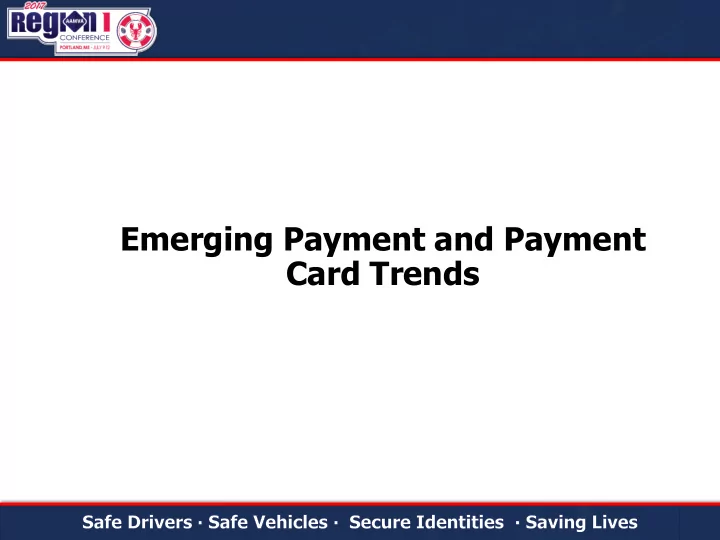

Emerging Payment and Payment Card Trends
Technical and operational requirements set by the PCI Security Standards Council (PCI SSC) to protect cardholder data. Applies to all entities that store, process, and/or transmit cardholder data. If you accept or process payment cards, PCI Data Security Standard (DSS) applies to you. Payment Card The PCI SSC is responsible for managing the security standards, enforced by the card brands: American Express, Discover Financial Industry Services, JCB, MasterCard, and Visa. (PCI) PCI DSS is a continuous process, entities are required to report on their PCI DSS compliance on an annual basis. Failure to comply may lead to fines and / or your ability to process credit cards.
Knowing Your Level 1 Level 2 Merchant Level and • Processing over 6 • Processing between 1 million credit card million and 6 million Reporting transactions per year credit card transactions Responsibilities per year • Requires annual onsite • Requires annual onsite • Assessment and assessment and quarterly approved quarterly ASV scans scanning vendors (ASV) scan Level 3 Level 4 • Processing between • Process less than 20K 20K and 1 million credit card transactions credit card transactions per year per year • Annual self • Annual self assessment and assessment and quarterly ASV scan quarterly ASV scan
Determine which system components PCI Process Lifecycle and networks are in scope for PCI DSS 1. Scope If required, perform remediation Assess the compliance of system to address requirements that are 6.Remediate 2. Assess components following the testing not in place, and provide an procedures for each PCI DSS updated report requirement 5. Submit 3. Report Submit the SAQ, ROC, AOC, and other requested Complete required documentation supporting documentation 4. Attest Self-Assessment Questionnaire such as ASV scan reports to (SAQ) or Report on Compliance the acquirer or to the payment (ROC) brand/requestor Complete the appropriate Attestation of Compliance (AOC)
Elements of Payment Card Data Render Stored Data Storage Data Element Unreadable per Permitted Requirement 3.4 Primary Account Yes Yes Number (PAN) Cardholder Name Yes No Cardholder Data Service Code Yes No Account Data Expiration Date Yes No Cannot store per Full Track Data3 No Requirement 3.2 Sensitive Cannot store per Authentication CAV2/CVC2/CVV2/CID4 No Requirement 3.2 of Data2 Cannot store per PIN/PIN Block5 No Requirement 3.2
What is new with PCI DSS v3.2? Multi Factor Authentication for administrative access into your credit card data environment Secure Sockets Layer (SSL) and early Transport Layer Security (TLS) not supported, have until June 30, 2018 to complete migration Key dates in becoming compliant with PCI DSS v3.2 • Any assessment started after October 2016 with be conducted using PCI DSS v3.2 • As of February 2018 all requirements within PCI DSS become effective
Techniques to Reducing Your Exposure and Scope Network Segmentation Storage of credit card data Point-to-Point Encryption (P2PE) Tokenization Outsourcing for payment processing
PCI Takeaways Determine your merchant level and compliance responsibility Document your credit card process flows Understand where your credit card data is within your network Document policies and procedures Determine ways to reduce your scope and risk exposure
Europay, MasterCard, and Visa (EMV) Unlike magnetic-stripe cards, every time an EMV card is used for payment, the card chip creates a unique transaction code that Characteristics: cannot be used again Helps to reduce fraud Visa reported chip enabled merchants saw 52% drop off in fraud in 2016 Since October 2015 the liability for card-present fraud has shifted to the party is the least EMV-compliant in a fraudulent transaction Metrics: Early rollout of EMV encountered performance problems Globally 52% of transactions are EMV United States, 52% of cards have EMV Technology, accounting for 18.6% of transactions
Mobile Wallets, Digital Payments and Contactless Payments Contactless POS and Payment Cards Utilizes Near Field Communication (NFC) and / or Biometrics Characteristics: Access to APIs Development of payment applications and back end services Reduces transactions cost for banks, thus reducing operating cost Metrics: $3.6 trillion in global transactions 20% growth since 2015 60% of this growth attributed to contactless payments
Mobile POS (mPos) and Cloud Based POS Cost effective Characteristics: Convenience, smaller footprint in retail space Accessibility for smaller merchants Forecast 27M + devices in United States by 2021, 3.2M in 2014 http://www.businessinsider.com/future-of-payments-trends-in-payment-processing-2016-10 Metrics: Estimated annual growth rate of 19% over next six years (2016- 2023) https://www.fractovia.org/news/industry-research-report/point-of-sale-pos-terminals-market
Cryptocurrency A digital or virtual currency that uses cryptography for security Not issued by a central authority Transfer of funds facilitated through the use of public and private keys Utilizes “block chain” Distributed database that is used to maintain a continuously growing list of records, “blocks” Managed in Peer-to-Peer network Volatile and varying degrees of fluctuation Lack of regulation
Emerging payment technology considerations: Desire to have quick and immediate transactions Contactless payments and payment technology on the rise Security and Regulation considerations with new technology
For More Information Contact: Brad Hanscom bhanscom@berrydunn.com Matthew Bria mbria@berrydunn.com
Recommend
More recommend